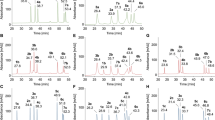Abstract
Glycation is a common class of nonenzymatic posttranslational modifications relevant for several diseases and cell aging in general, such as D-glucose-derived modifications at the ɛ-amino groups of lysine residues in blood proteins, especially albumin, immunoglobulin, and hemoglobin, for diabetic patients. These Amadori compounds are identified on the peptide level after enzymatic digestion and chromatographic separation by mass spectrometry. Their syntheses usually rely on a global glycation approach. Both areas require the reliable separation of glycated peptides from their unmodified congeners present in different ratios, which is typically not achieved by standard eluent systems in ion-pairing RP-HPLC (IP-RPLC). Here, we compare aqueous acetonitrile and methanol gradients containing either trifluoroacetic acid (TFA) or heptafluorobutyric acid (HFBA) as ion-pairing agents to separate such peptide pairs. TFA-containing eluents resulted in rather low resolutions, and the glycated and unglycated peptides often coeluted. HFBA increased the retention times of the unmodified peptide more than for the glycated peptide thereby improving the separation of all eight studied peptide pairs, even achieving baseline separations for some sequences. Thus the use of HFBA as ion-pair reagent provides a universally applicable eluent system in IP-RPLC to separate glycated peptides from their unmodified counterparts, even at the preparative scale required for synthetic peptides.


Similar content being viewed by others
References
Mann M, Jensenn ON (2003) Nat Biotechnol 21:255–261
Traverso N, Menini S, Cottalasso D, Odetti P, Marinari UM, Pronzato MA (1997) Biochim Biophys Acta 1336:409–418
Stadtman ER, Levine RL (2003) Amino Acids 25:207–218
Wright HT (1991) Protein Eng 4:283–294
Portero-Otin M, Bellmunt MJ, Requena JR, Pamplona R (2003) Biochem Soc Trans 31:1403–1405
Lapolla A, Fedele D, Aronica R, Garbeglio M, D’Alpaos M, Plebani M, Seraglia R, Traldi P (1997) Rapid Commun Mass Spectrom 11:613–617
Ulrich P, Cerami A (2001) Recent Prog Horm Res 56:1–21
Stultz CM, Edelman ER (2003) Biophys J 85:2198–2204
Schalkwijk CG, Ligtvoet N, Twaalfhoven H, Jager A, Blaauwgeers HG, Schlingemann RO, Tarnow L, Parving HH, Stehouwer CDA, van Hinsberg VW (1999) Diabetes 48:2446–2453
Baynes JW, Thorpe SR (1999) Diabetes 48:1–9
Ledesma MD, Bonay P, Avila J (1995) J Neurochem 65:1658–1664
Ge SJ, Lee TC (1996) J Agric Food Chem 44:1053–1057
Reutter M, Eichner K (1989) Z Lebensm Unters Forsch 188:28–35
Lapolla A, Fedele D, Reitano R, Arico NC, Seraglia R, Traldi P, Marotta E, Tonani R (2004) J Am Soc Mass Spectrom 15:496–509
Frolov A, Hoffmann P, Hoffmann R (2006) J Mass Spec 41:1459–1469
Zhang Q, Tang N, Brock JWC, Mottaz HM, Ames JM, Baynes JW, Smith RD, Metz TO (2007) J Proteome Res 6:2323–2330
Lapolla A, Brancia FL, Bereszczak J, Fedele D, Baccarin L, Seraglia R, Traldi P (2007) Mol Nutr Food Res 51:456–461
Frolov A, Singer D, Hoffmann R (2007) J Pept Sci 13:862–867
Stefanowicz P, Kapczynska K, Kluczyc A, Szewczuk Z (2007) Tetrahedron Lett 48:967–969
O’Harte FP, Gray AM, Flatt PR (1998) J Endocrinol 156:237–243
Jakas A, Horvat S (2003) Biopolymers 69:421–431
Frolov A, Singer D, Hoffmann R (2006) J Pept Sci 12:389–395
Jakas A, Horvat S (1996) J Chem Soc Perkin Trans II 231:789–794
Linetsky MD, Shipova EV, Legrand RD, Argirov OO (2005) Biochim Biophys Acta 1724:181–193
Rich DH, Singh J (1979) The carbodiimide method. In: Gross E, Meinenhofer J (eds) The peptides. Academic, New York, pp 241–261
Aletras A, Barlos K, Gatos D, Koutsogianni S, Mamos P (1995) Epitheor Klin Farmacol Farmakokinet Int Ed 9:129
Frolov A, Hoffmann R (2008) Ann N Y Acad Sci 1126:253–256
Garcia MC (2005) J Chromatogr B 825:111–123
Apffel A, Fischer S, Goldberg G, Goodley PC, Kuhlmann FE (1995) J Chromatogr A 712:177–190
Chong BE, Yan F, Lubman DM, Miller FR (2001) Rapid Commun Mass Spectrom 15:291–296
Author information
Authors and Affiliations
Corresponding author
Rights and permissions
About this article
Cite this article
Frolov, A., Hoffmann, R. Separation of Amadori peptides from their unmodified analogs by ion-pairing RP-HPLC with heptafluorobutyric acid as ion-pair reagent. Anal Bioanal Chem 392, 1209–1214 (2008). https://doi.org/10.1007/s00216-008-2377-1
Received:
Revised:
Accepted:
Published:
Issue Date:
DOI: https://doi.org/10.1007/s00216-008-2377-1




